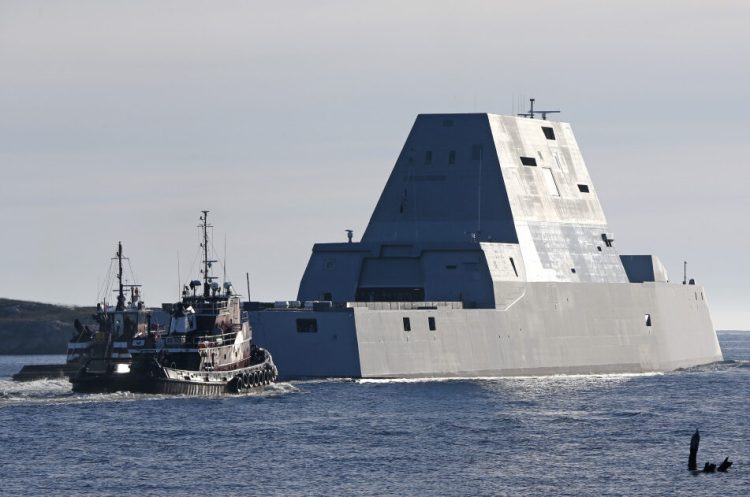A federal watchdog agency has again flagged issues with high-tech warships built at Bath Iron Works as the shipyard aims to finish work on the three vessels ordered by the Navy.
After 20 years and more than $25 billion, the Navy will have three new ships without a usable weapon system or a defined role in the U.S. fleet, the Government Accountability Office said.
But defense analysts say the current shortfalls in Zumwalt-class destroyers, referred to as DDG 1000, are the result of Pentagon indecision, not poor workmanship at BIW. The shipyard has delivered two ships, the USS Zumwalt and the USS Michael Monsoor. A third ship is under construction in Bath.
“Maybe there are one or two other shipyards in the whole world that could have built this ship,” said Loren Thompson, chief operating officer of the Lexington Institute, a nonprofit research group outside Washington, D.C.
“What you find is most of the issues with the Zumwalt have nothing to do with the shipyard,” Thompson added. “It has to do with the Navy and the Pentagon making up their minds about what they were trying to get accomplished.”
In a two-page entry of its annual weapon systems assessment, GAO analysts noted that Navy inspectors in 2016 and last year found hundreds of “serious deficiencies” in the two ships that have been constructed. “This increases the likelihood that the ship will not be fully capable and sustainable when provided to the fleet,” the office reported. The USS Zumwalt, the first of the DDG 1000s built at BIW, was slated for final delivery this month.
Among other issues is that the Navy has not found a replacement ammunition for the ships’ main gun, after deciding its specialized ammo, at $800,000 per round, was too expensive.
“As a result, the guns will remain inoperable on the ships for the foreseeable future,” the report said. The Navy is considering another $1 billion to outfit the ships with cruise missiles for surface attacks.
In addition, the Navy has authorized BIW to borrow parts from the ship under construction to limit delays in the final delivery of the two other ships. It is unclear whether taking those parts will delay the final delivery of that ship in 2022.
AN $8.4 BILLION PRICE
Developing the ships has cost $11.8 billion, almost five times the $2.5 billion estimated in 1998, the GAO report said. The total cost for each ship, including research and development, was $8.4 billion as of last year, seven times more than expected when the program started.
Cost overruns and delays can be mostly blamed on numerous vessel design changes even after fabrication of the ships began in 2009, the GAO said.
“Nearly 10 years later, development and shipboard testing of technologies continues, each of which could lead to discovery that could disrupt the design stability the Navy currently claims,” the agency said.
The report is not surprising for industry insiders, but the fact that the warships have no combat systems or a usable weapon could raise eyebrows in the general public, said Bryan Clark, a senior fellow at the Center for Strategic and Budgetary Assessments.
“I think most people who have not been paying close attention would see that as some significant shortfalls in a ship that costs between $6 billion and $8 billion apiece,” Clark said.
The Zumwalt destroyers were conceived as stealthy vessels that could get in close to shore and support ground forces with precise fire from advanced deck weapons.
But as the project moved forward, and the U.S. military became entangled in ground wars in mostly land-locked countries like Afghanistan, the function of the ship became less clear. The Navy cut down its original order for 32 ships to only three.
Now, the Navy has a vessel with cutting-edge technology, a new hull design and an all-electric engine capable of producing huge amounts of energy, but without a clear role.
“The whole enterprise was a series of bad decisions resulting in the ship costing way more than was expected, delivered in smaller numbers and now doesn’t have the ability to conduct combat operations,” Clark said.
Clark and others believe the Zumwalts will likely be used as platforms for testing futuristic weapons like lasers and rail guns, to launch drones, or as command and control. Overall, the program was hugely expensive, but may have important lessons and technology for future Navy ship design, Clark said.
Officials at BIW have said they prepared the shipyard to build Zumwalt-class ships for years, changes that made switching to build the Arleigh Burke-class destroyers again challenging.
Last year, the shipyard, which employs about 5,500 workers was awarded a $3.9 billion contract to build four Arleigh-Burke destroyers over the next four years.
Send questions/comments to the editors.




Comments are no longer available on this story